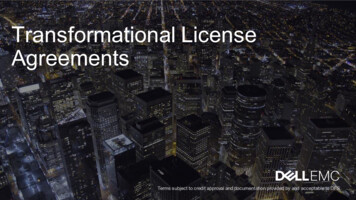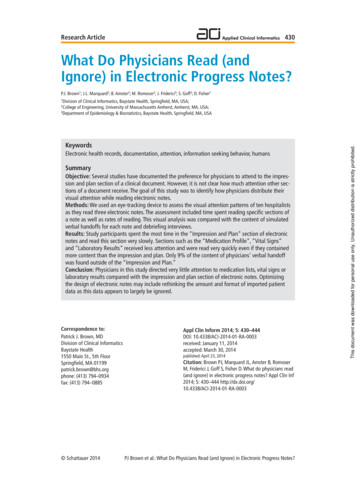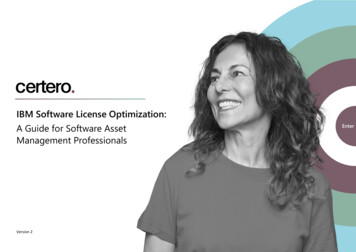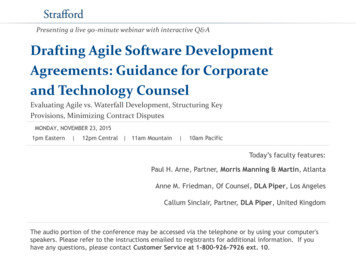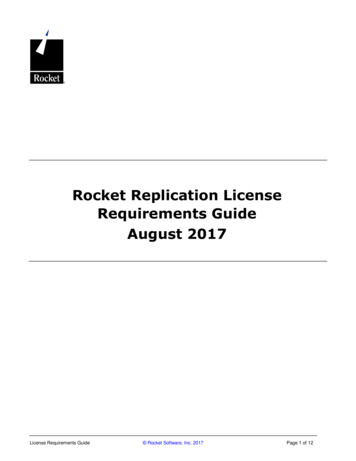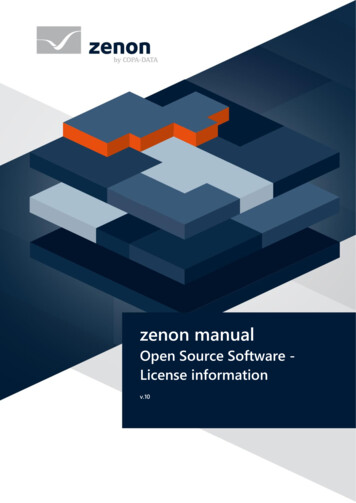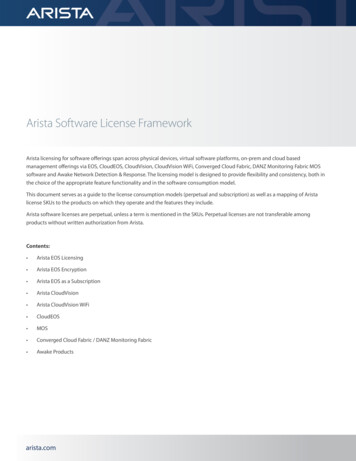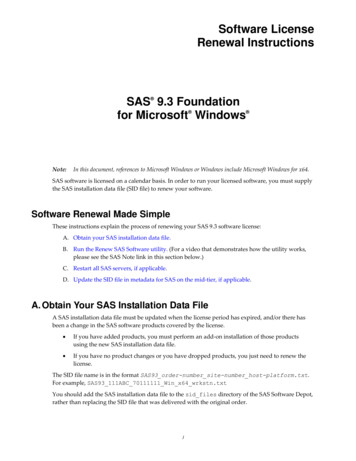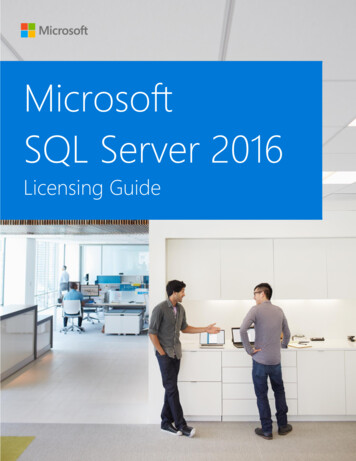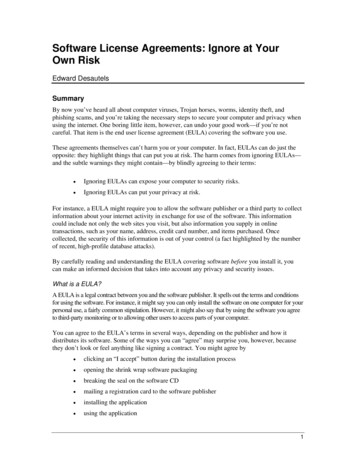
Transcription
Software License Agreements: Ignore at YourOwn RiskEdward DesautelsSummaryBy now you’ve heard all about computer viruses, Trojan horses, worms, identity theft, andphishing scams, and you’re taking the necessary steps to secure your computer and privacy whenusing the internet. One boring little item, however, can undo your good work—if you’re notcareful. That item is the end user license agreement (EULA) covering the software you use.These agreements themselves can’t harm you or your computer. In fact, EULAs can do just theopposite: they highlight things that can put you at risk. The harm comes from ignoring EULAs—and the subtle warnings they might contain—by blindly agreeing to their terms: Ignoring EULAs can expose your computer to security risks. Ignoring EULAs can put your privacy at risk.For instance, a EULA might require you to allow the software publisher or a third party to collectinformation about your internet activity in exchange for use of the software. This informationcould include not only the web sites you visit, but also information you supply in onlinetransactions, such as your name, address, credit card number, and items purchased. Oncecollected, the security of this information is out of your control (a fact highlighted by the numberof recent, high-profile database attacks).By carefully reading and understanding the EULA covering software before you install it, youcan make an informed decision that takes into account any privacy and security issues.What is a EULA?A EULA is a legal contract between you and the software publisher. It spells out the terms and conditionsfor using the software. For instance, it might say you can only install the software on one computer for yourpersonal use, a fairly common stipulation. However, it might also say that by using the software you agreeto third-party monitoring or to allowing other users to access parts of your computer.You can agree to the EULA’s terms in several ways, depending on the publisher and how itdistributes its software. Some of the ways you can “agree” may surprise you, however, becausethey don’t look or feel anything like signing a contract. You might agree by clicking an “I accept” button during the installation process opening the shrink wrap software packaging breaking the seal on the software CD mailing a registration card to the software publisher installing the application using the application1
US-CERTEnd-User License Agreements:Security and Privacy ImplicationsYou can refuse to accept the terms and conditions of the EULA, but then you can’t legally use thesoftware.Why EULAs are ImportantEULAs can include a number of items you should seriously consider before installing thesoftware. In general, you should note the following facts about EULAs: EULAs are legally binding. Some consumer advocates have challenged the legalityof EULAs, especially long agreements clouded in complicated “legalese.” Theadvocates argue these EULAs are a strategy for discouraging careful review andhiding controversial terms and conditions. However, a number of influential courtdecisions have upheld the legality of EULAs, so you need to assume you’re enteringinto legal agreements when you accept their terms. EULAs restrict how you can use the software. EULAs often include clauses thatlimit the number of computers you can load the software on. They sometimes alsoprohibit reverse engineering for the purpose of creating compatible software. In somecases they prohibit software testing and even publishing the results of this testing. EULAs may force you to agree to certain conditions when using the software.Many software bundles force you to use all bundled components, including softwareproduced by third-party publishers. They may also require you to agree to monitoringof your internet activity and/or sharing your computer’s resources. EULAs can limit your ability to sue for damages. Most EULAs include a clausethat says you cannot sue the publisher for any damages caused by using the software.The above items are detailed in the section “A Closer Look: EULAs, Security, and Privacy.”What to Look Out ForBecause software EULAs can impose terms and conditions that affect your online security andprivacy, you should carefully consider what you’re willing to allow in exchange for the use of thesoftware. You should be particularly concerned about EULAs that allow the software publisher or third parties to monitor your internet activity allow the software publisher or third parties to collect your personal information allow the software publisher or third parties to use your computing resources hold you to the terms of EULAs governing third-party software componentsWhat You Should DoThe following list presents recommendations for protecting yourself from the security andprivacy problems associated with EULAs. These recommendations are explained in detail in thesection “What You Can Do to Protect Yourself.”2
US-CERTEnd-User License Agreements:Security and Privacy Implications Read the EULA before you install the software. It can be painfully boring reading,but this is the only way to know exactly what privacy and security risks you might betaking by agreeing to the EULA’s terms. Consider the software publisher. If you don’t know about the publisher or if youhave any question about its integrity, review the EULA covering its software withextra care. Beware of firewall prompts when installing software. Firewall prompts asking youto allow certain traffic to pass may be cause for concern. Review the EULA to findout why this traffic must be allowed and whether you wish to allow it. Beware of “free” software, especially peer-to-peer (P2P) file-sharing software.Rarely is anything truly free. Review the EULA to find out what you need to do orallow in exchange for using the software, and evaluate what impact this might haveon the security of your computer and personal information.A Closer Look: EULAs, Security, and PrivacyThe following sections provide real-world examples of the privacy and security issues thatresulted from ignoring EULAs or agreeing to EULA terms that opened users to risk. This risk canalso result from poorly managed software partnership situations in which the primary softwarepublisher fails to check its partners’ software for bugs, security issues, and compliance with itsEULA. What’s more, the risk you sign onto when agreeing to certain EULA terms is not limitedto your own computer or information, but can extend to other computers and data connected toyour network.Monitoring Software EULAsAn interesting episode highlights the way EULAs and bundled software can combine to createsecurity dilemmas. The IT department of a major university noticed many users on its networkrunning a troublesome piece of software packaged as a tool for speeding internet downloads andprotecting email from viruses. Bundled with it, however, was adware that collected a great deal ofsensitive information about the users, including information from encrypted, secure socket layer(SSL) sessions. The EULA for this software included the following: [this software] monitors all of your Internet behavior, including both the normal webbrowsing you perform, and also the activity you may have through secure sessions, suchas when filling a shopping basket or filling out an application form that may containpersonal financial and health information.You should scrutinize and evaluate any EULA that requires you to allow monitoring of youronline activity. You need to determine how comfortable you are placing personal information inthe hands of a third party.Even if you are comfortable surrendering this kind of information to a third party, you shouldunderstand that monitoring software can create wider privacy and security problems. In this case,the university IT department was particularly concerned about SSL-protected data accessible onits network. Because the monitoring software could collect data from SSL-encrypted sessions, thefollowing data was at risk:3
US-CERTEnd-User License Agreements:Security and Privacy Implications critical university information personal information network IDs and passwords federally regulated dataBecause of this threat, the IT department blocked all connections attempted by the software andredirected users to a web page that explained the problem and provided instructions for removingthe software from their computers. So, when evaluating the effect of a EULA on security andprivacy, consider your duty as a “good citizen” of your network: Think about the wider privacyand security problems your software might create.File-Sharing EULAsPeer-to-peer (P2P) file-sharing programs have become popular, but they create numerousheadaches for those concerned about privacy and security. By agreeing to the EULAs coveringthis software, you’re allowing third parties to monitor your internet activity and share thisinformation with advertisers. You’re also agreeing to open up directories on your computer foraccess by others. One popular P2P program even requires you to install bundled softwaredesigned to transform your computer into a distribution channel for third-party software andcontent publishers.When evaluating the EULAs for P2P file-sharing programs, you should seriously considerwhether you’re comfortable surrendering control over directories on your computer, allowingothers to access these directories, and, in some cases, allowing others to upload content to yourcomputer. You should also consider whether you’re comfortable allowing a third party to monitoryour internet activity. Can you trust that those accessing your computer will not try to gain accessbeyond the designated directories? Can you trust the files uploaded to your computer do notcontain viruses or illicit content? Can you trust assurances that the information gathered throughmonitoring will be encrypted or that personally identifiable information will not be collected (see“Third-Party Software and Cascading EULAs” below)?The Australian Computer Emergency Response Team lists the following dangers associated withP2P file-sharing software: enhanced vulnerability to Trojan horses and viruses enhanced risk to your personal data enhanced exposure to software flaws that can harm your computer enhanced exposure to security workarounds that can leave your computer open toabuseResource Sharing EULAsIn a noted case, a free internet service provider changed the terms of its EULA to support itsmove into the arena of supercomputing. The revised agreement required users to allow the4
US-CERTEnd-User License Agreements:Security and Privacy Implicationsinstallation of software that would support the provider’s supercomputing venture. The agreementalso required users to leave their computers on at all times so their resources would be availablewhen needed. The EULA prohibited removal of this software and required users to allow it tomake modem connections as needed to the provider’s servers.You should approach any request to surrender even partial control of your computer to a thirdparty with extreme caution. Surrendering this control may enable the third party to reconfigureyour computer in ways that weaken its security, such as by creating holes in personal firewalls orcommunications channels that bypass existing security mechanisms. Also, in the example of theinternet service provider mentioned above, those agreeing to the revised EULA could havebecome accustomed to their computers connecting to the internet independently. Would theseusers know if a connection was the result of a virus or spyware and not the resource sharingsoftware?Third-Party Software and Cascading EULAsIn many cases, the software you purchase or download is bundled with third-party software.Sometimes, the EULA covering the primary software (for instance, a file-sharing program) saysthat you must also install the third-party software bundled with it (for instance, adware) and thatyou cannot disable or alter the third-party software. Normally, these third-party components havetheir own EULA which can, in turn, include “downstream” third-party components also coveredby their own EULAs. This can make it hard for you to determine what you’re agreeing to whenyou install the software and what affect all these EULAs have on your security and privacy.The following diagram illustrates the problem.Figure 1, Cascading EULAs. “Downstream” third-party software EULAscan become numerous, making it hard for you to completely understand theterms and conditions under which you will use the software. It also raisesconcern over how much the primary software publisher knows about thedownstream third-party software components and their license agreements.5
US-CERTEnd-User License Agreements:Security and Privacy ImplicationsIn 2002, four popular file-sharing programs were affected by a Trojan horse bundled into theirreleases. The Trojan horse was introduced by a third-party advertising software partner. Theadvertising partner failed to recognize one of its components—itself supplied by a third-partyfurther downstream—as a bogus application. The application presented itself as an online contestbut actually contained the Trojan horse W32.Dlder.Trojan. When unsuspecting users clicked alink hoping to win a prize, the Trojan horse quietly installed itself on the users’ computers. It thenlogged web sites visited by the users, posted them to a web site, and opened a security hole in theusers’ systems.Responding to this incident, the chief technical officer for one of the file-sharing companiesinvolved stated, “We rely on [the advertising partner] to deal with our ad deals and bundledsoftware. We assumed that they did their homework on this package but that does not seem to bethe case.” The public relations manager for one of the other file-sharing companies involvedadmitted, “We were unaware of what this program did when we added it to our installs .”This case demonstrates why you should exercise caution when presented with a EULA that holdsyou to the terms of all third-party software EULAs. You cannot assume that the primary softwarepublisher has evaluated third-party EULAs and software.What You Can Do to Protect YourselfWhile EULAs rarely attract the kind of attention lavished on viruses or phishing schemes, theyare an important consideration when managing the security of your computer and privateinformation. The following sections present recommendations for protecting yourself from thesecurity and privacy problems associated with EULAs.Read the EULAThis is the most important step you can take: Before installing any software, take the time to readits EULA. While you might incur a half hour of boring reading, doing so can spare you securityand privacy headaches.If the EULA is lengthy or you find it difficult to read in the installation interface, copy it into aword processing document, quit the installation, and carefully read the agreement beforeproceeding. Make sure you understand the agreement’s terms and conditions, and that you agreewith them. Contact the software publisher with any questions you might have or if you needclarification about any specific points.Packaged software purchased off the shelf can present something of a catch-22: How can youagree to the terms and conditions of the EULA when the package states that breaking the shrinkwrap constitutes agreement? To get around this problem, consult the software publisher’s website. Software publishers often make their EULAs available online. Note the version ID ornumber and other pertinent information from the packaging to help ensure you read the EULA forthe specific version of the software. Contact the publisher directly if you cannot locate the EULAfor the software you’re interested in.6
US-CERTEnd-User License Agreements:Security and Privacy ImplicationsConsider the Software PublisherWhile there is no guarantee you will agree to the terms of any given EULA, established softwarepublishers that have built strong business reputations are less likely to engage in questionablebusiness practices. This includes unusual, misleading, or camouflaged terms and conditions in theEULAs governing the use of their software. You should not, however, use a company’s strongbusiness reputation as an excuse for not reading its EULA. A company’s good corporatereputation does not mean you will necessarily agree with the terms and conditions of its software.When dealing with software published by a company or organization with which you’re notfamiliar, you may want to review its software EULAs with added scrutiny. Particular vigilance isrecommended when the software is bundled with other software from third-party publishers. Beprepared to read the EULAs for third-party components when necessary.Beware of Firewall Prompts When Installing SoftwareDuring installation, if your personal firewall generates a prompt asking whether you want toallow certain inbound or outbound connections, proceed with caution. You should verify that thesoftware requires changes to your firewall settings for normal operation, and that you arecomfortable with this operation. For instance, the EULA may require you to allow monitoring ofyour activity, access to specified directories (as in file-sharing programs), or use of yourcomputer’s resources. These provisions may require the opening of holes in your personalfirewall.Note, however, that in the case of bundled software, EULAs requiring you to allow monitoring,directory access, etc. may not be in the primary software’s EULA. These EULA requirementsmay be in the third-party software EULAs.Firewall prompts may also be a sign that rogue software has been bundled into the softwarepackage you’re installing. This was the case in the file-sharing Trojan horse discussed earlier.If you’re in doubt about whether to change your firewall settings based on prompts receivedduring software installation, consult the software’s user or installation guide. If no guide isavailable, or if you are still unsure about allowing the traffic through your firewall afterconsulting it, contact the software publisher before making any changes.Note that some personal firewalls include options to allow one-time or case-by-case connections.This option may be useful if you are reasonably certain about the legitimacy of a request. Forinstance, some software attempts to connect to a server during the registration process. If you arecomfortable with this request, you can approve the connection for the purposes of registration, butdeny all future connections.Beware of “Free” SoftwareThe old saying tells us “there is no free lunch.” This applies to software. Many “free” softwareprograms, such as the file-sharing programs discussed earlier, often exact a non-monetary chargefor their use. This non-monetary charge is detailed in the EULA and specifies what you mustallow or provide in exchange for use of the software. This may include mandatory installation ofcomponents that compromise your security and/or privacy.7
US-CERTEnd-User License Agreements:Security and Privacy ImplicationsGlossaryAdware:A software application that displays advertising when the program is running.The software may display ads in pop-up windows or a bar in the frame of theapplication window.Back door:A back door is a means of access to a computer program that bypasses securitymechanisms.P2PAn internet network in which a group of computer users, each equipped with thesame networking program, can connect to each other and directly access filesfrom one another's computers.PGP:(Pretty Good Privacy) is a program used to encrypt and decrypt data, primarily email, over the internet.SSL(Secure Sockets Layer) is a method for securing information exchange on theinternet. SSL uses data encryption and digital certificate authentication to securethe information exchange.SpywareAdware that tracks user activity and passes it to third parties without the user'sknowledge or consent.Supe
Monitoring Software EULAs . An interesting episode highlights the way EULAs and bundled software can combine to create security dilemmas. The IT department of a major university noticed many users on its network running a troublesome piece of software packaged as a tool for speed
